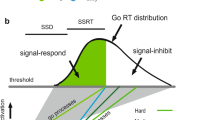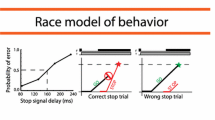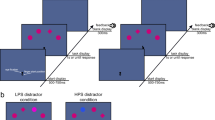Abstract
We investigated how the ability to suppress an impending movement is affected by the visual salience of the stop-signal in a reaching countermanding task. We found that when the stop-signal was easy to detect, stop performance was better than when the stop-signal was difficult to detect. In an exploratory analysis, we also found that the change in salience of the stop-signal can have an effect on the speed of response in trials following the stop-signal. This effect occurred together with strategic slowing down after an error in inhibiting was committed and together with a repetition priming effect due to the stop-signal presented in the previous trial. Our results suggest the need to investigate more in depth the afferent processing stage of the inhibitory control of movement and how task demands can affect its functioning.



Similar content being viewed by others
References
Armstrong IT, Munoz DP (2003) Inhibitory control of eye movements during oculomotor countermanding in adults with attention-deficit hyperactivity disorder. Exp Brain Res 152:444–452
Asrress KN, Carpenter RH (2001) Saccadic countermanding: a comparison of central and peripheral stop signals. Vis Res 41:2645–2651
Band GP, Van der Molen MW, Logan GD (2003) Horse-race model simulations of the stop-signal procedure. Acta Psychol 112:105–142
Bari A, Robbins TW (2013) Inhibition and impulsivity: behavioral and neural basis of response control. Progr Neurobiol 108:44–79
Bekker EM, Overtoom CCE, Kooij JJS, Buitelaar JK, Verbaten MN, Kenemans JL (2005) Disentangling deficits in adults with attention-deficit/hyperactivity disorder. Arch Gen Psychiatry 62:1129–1136
Bissett PG, Logan GD (2011) Balancing cognitive demands: control adjustments in the stop-signal paradigm. J Exp Psychol Learn Mem Cogn 37:392–404
Bissett PG, Logan GD (2012) Post-stop-signal adjustments: inhibition improves subsequent inhibition. J Exp Psychol Learn Mem Cogn 38:955–966
Botvinick MM, Braver TS, Barch DM, Carter CS, Cohen JD (2001) Conflict monitoring and cognitive control. Psychol Rev 108:624–652
Boucher L, Palmeri TJ, Logan GD, Schall JD (2007) Inhibitory control in mind and brain: an interactive race model of countermanding saccades. Psychol Rev 114:376–397
Brunamonti E, Ferraina S, Paré M (2012) Controlled movement processing: evidence for a common inhibitory control of finger, wrist, and arm movements. Neuroscience 215:69–78
Cabel DW, Armstrong IT, Reingold E, Munoz DP (2000) Control of saccade initiation in a countermanding task using visual and auditory stop signals. Exp Brain Res 133:431–441
Camalier CR, Gotler A, Murthy A, Thompson KG, Logan GD, Palmeri TJ, Schall JD (2007) Dynamics of saccade target selection: race model analysis of double step and search step saccade production in human and macaque. Vis Res 47:2187–2211
Cavina-Pratesi C, Bricolo E, Prior M, Marzi CA (2001) Redundancy gain in the stop-signal paradigm: implications for the locus of coactivation in simple reaction time. J Exp Psychol Hum Percept Perform 27:932–941
Chamberlain SR, Blackwell AD, Fineberg NA, Robbins TW, Sahakian BJ (2005) The neuropsychology of obsessive compulsive disorder: the importance of failures in cognitive and behavioural inhibition as candidate endophenotypic markers. Neurosci Biobehav Rev 29:399–419
Chambers CD, Bellgrove MA, Gould IC, English T, Garavan H, McNaught E, Kamke M, Mattingley JB (2007) Dissociable mechanisms of cognitive control in prefrontal and premotor cortex. J Neurophysiol 98:3638–3647
Dutilh G, Vandekerckhove J, Forstmann BU, Keuleers E, Brysbaert M, Wagenmakers EJ (2012) Testing theories of post-error slowing. Atten Percept Psychophys 74:454–465
Elchlepp H, Lavric A, Chambers CD, Verbruggen F (2016) Proactive inhibitory control: a general biasing account. Cogn Psychol 86:27–61
Emeric EE, Brown JW, Boucher L, Carpenter RH, Hanes DP, Harris R, Logan GD, Mashru RN, Paré M, Pouge P, Stuphorn V, Taylor TL, Schall JD (2007) Influence of history on saccade countermanding performance in humans and macaque monkeys. Vis Res 47:35–49
Enticott PG, Bradshaw JL, Bellgrove MA, Upton DJ, Ogloff JRP (2009) Stop task after-effects: the extent of slowing during the preparation and execution of movement. Exp Psychol 56:247–251
Faul F, Erdfelder E, Lang AG, Buchner A (2007) G*Power 3: a flexible statistical power analysis program for the social, behavioral, and biomedical sciences. Behav Res Methods 39:175–191
Faul F, Erdfelder E, Buchner A, Lang AG (2009) Statistical power analyses using G*Power 3.1: tests for correlation and regression analyses. Behav Res Methods 41:1149–1160
Gauggel S, Rieger M, Feghoff TA (2004) Inhibition of ongoing responses in patients with Parkinson’s disease. J Neurol Neurosurg Psychiatry 75:539–544
Hughes ME, Fulham WR, Johnston PJ, Michie PT (2012) Stop-signal response inhibition in schizophrenia: behavioural, event-related potential and functional neuroimaging data. Biol Psychol 89:220–231
Jahfari S, Ridderinkhof KR, Scholte HS (2013) Spatial frequency information modulates response inhibition and decision-making processes. PLoS One 8:76467
Langford ZD, Krebs RM, Talsma D, Woldorff MG, Boehler CN (2016) Strategic down-regulation of attentional resources as a mechanism of proactive response inhibition. Eur J Neurosci 44:2095–2103
Liddle EB, Scerif G, Hollis CP, Batty MJ, Groom MJ, Liotti M, Liddle PF (2009) Looking before you leap: a theory of motivated control of action. Cognition 112:141–158
Lipszyc J, Schachar R (2010) Inhibitory control and psychopathology: a meta-analysis of studies using the stop signal task. J Int Neuropsychol Soc 16:1064–1076
Logan GD, Cowan WB (1984) On the ability to inhibit thought and action: a theory of an act of control. Psychol Rev 91:295–327
Logan GD, Yamaguchi M, Schall JD, Palmeri TJ (2015) Inhibitory control in mind and brain 2.0: blocked-input models of saccadic countermanding. Psychol Rev 122:115–147
Lúcio PS, Salum GA, Rohde LA, Swardfager W, Gadelha A, Vandekerckhove J, Pan PM, Polanczyk GV, do Rosário MC, Jackowski AP, Mari JJ, Cogo-Moreira H (2016) Poor stimulus discriminability as a common neuropsychological deficit between ADHD and reading ability in young children: a moderated mediation model. Psychol Med 47:255–266
Matzke D, Love J, Heathcote A (2017) A Bayesian approach for estimating the probability of trigger failures in the stop-signal paradigm. Behav Res Methods 49:267–281
Mione V, Canterini S, Brunamonti E, Pani P, Donno F, Fiorenza MT, Ferraina S (2015) Both the COMT Val158Met single-nucleotide polymorphism and sex-dependent differences influence response inhibition. Front Behav Neurosci 9:127
Mirabella G, Pani P, Paré M, Ferraina S (2006) Inhibitory control of reaching movements in humans. Exp Brain Res 174:240–255
Mirabella G, Pani P, Ferraina S (2008) Context influences on the preparation and execution of reaching movements. Cogn Neuropsychol 25:996–1010
Mirabella G, Pani P, Ferraina S (2009) The presence of visual gap affects the duration of stopping process. Exp Brain Res 192:199–209
Mirabella G, Pani P, Ferraina S (2011) Neural correlates of cognitive control of reaching movements in the dorsal premotor cortex of rhesus monkeys. J Neurophysiol 106:1454–1466
Morein-Zamir S, Kingstone A (2006) Fixation offset and stop signal intensity effects on saccadic countermanding: a crossmodal investigation. Exp Brain Res 175:453–462
Nelson MJ, Boucher L, Logan GD, Palmeri TJ, Schall JD (2010) Non independent and non stationary response times in stopping and stepping saccade tasks. Atten Percept Psychophys 72:1913–1929
Notebaert W, Houtman F, Opstal FV, Gevers W, Fias W, Verguts T (2009) Post-error slowing: an orienting account. Cognition 111:275–279
Oosterlaan J, Logan GD, Sergeant JA (1998) Response inhibition in AD/HD, CD, comorbid AD/HD + CD, anxious, and control children: a meta-analysis of studies with the stop task. J Child Psychol Psychiatry 39:411–425
Osman A, Kornblum S, Meyer DE (1986) The point of no return in choice reaction time: controlled and ballistic stages of response preparation. J Exp Psychol Hum Percept Perform 12:243–258
Osman A, Kornblum S, Meyer DE (1990) Does motor programming necessitate response execution? J Exp Psychol Hum Percept Perform 16:183–198
Pani P, Menghini D, Napolitano C, Calcagni M, Armando M, Sergeant JA, Vicari S (2013) Proactive and reactive control of movement are differently affected in attention deficit hyperactivity disorder children. Res Dev Disabil 34:3104–3111
Pouget P, Logan GD, Palmeri TJ, Boucher L, Paré M, Schall JD (2011) Neural basis of adaptive response time adjustment during saccade countermanding. J Neurosci 31:12604–12612
Rieger M, Gauggel S (1999) Inhibitory after-effects in the stop signal paradigm. Brit J Psychol 90:509–518
Salinas E, Stanford TR (2013) The countermanding task revisited: fast stimulus detection is a key determinant of psychophysical performance. J Neurosci 33:5668–5685
Salum GA, Sergeant J, Sonuga-Barke E, Vandekerckhove J, Gadelha A, Pan PM, Moriyama TS, Graeff-Martins AS, de Alvarenga PG, do Rosário MC, Manfro GG, Polanczyk G, Rohde LA (2014) Specificity of basic information processing and inhibitory control in attention deficit hyperactivity disorder. Psychol Med 44:617–631
Sanders AF, Wertheim AH (1973) The relation between physical stimulus properties and the effect of foreperiod duration on reaction time. Q J Exp Psychol 25:201–206
Schachar RJ, Chen S, Logan GD, Ornstein TJ, Crosbie J, Ickowicz A, Pakulak A (2004) Evidence for an error monitoring deficit in attention deficit hyperactivity disorder. J Abnorm Child Psychol 32:285–293
Stevenson SA, Elsley JK, Corneil BD (2009) A “gap effect” on stop signal reaction times in a human saccadic countermanding task. J Neurophysiol 101:580–590
Thakkar KN, Schall JD, Boucher L, Logan GD, Park S (2011) Response inhibition and response monitoring in a saccadic countermanding task in schizophrenia. Biol Psychiatry 69:55–62
van den Wildenberg WP, van der Molen MW (2004) Additive factors analysis of inhibitory processing in the stop-signal paradigm. Brain Cogn 56:253–266
van der Schoot M, Licht R, Horsley TM, Sergeant JA (2005) Effects of stop signal modality, stop signal intensity and tracking method on inhibitory performance as determined by use of the stop signal paradigm. Scand J Psychol 46:331–341
van Gaal S, Ridderinkhof KR, van den Wildenberg WP, Lamme VA (2009) Dissociating consciousness from inhibitory control: evidence for unconsciously triggered response inhibition in the stop-signal task. J Exp Psychol Hum Percept Perform 35:1129–1139
Verbruggen F, Logan GD (2008) Response inhibition in the stop-signal paradigm. Trends Cogn Sci 12:418–424
Verbruggen F, Logan GD (2009a) Models of response inhibition in the stop-signal and stop-change paradigms. Neurosci Biobehav Rev 33:647–661
Verbruggen F, Logan GD (2009b) Proactive adjustments of response strategies in the stop-signal paradigm. J Exp Psychol Hum Percept Perform 35:835–854
Verbruggen F, Logan GD (2015) Evidence for capacity sharing when stopping. Cognition 142:81–95
Verbruggen F, Liefooghe B, Vandierendonck A (2004) The interaction between stop signal inhibition and distractor interference in the flanker and Stroop task. Acta Psychol 116:21–37
Verbruggen F, Logan GD, Liefooghe B, Vandierendonck A (2008) Short-term aftereffects of response inhibition: repetition priming or between-trial control adjustments? J Exp Psychol Hum Percept Perform 34:413–426
Verbruggen F, Chambers CD, Logan GD (2013) Fictitious inhibitory differences: how skewness and slowing distort the estimation of stopping latencies. Psychol Sci 24:352–362
Verbruggen F, McLaren IPL, Chambers CD (2014a) Banishing the control homunculi in studies of action control and behavior change. Perspect Psychol Sci 9:497–524
Verbruggen F, Stevens T, Chambers CD (2014b) Proactive and reactive stopping when distracted: an attentional account. J Exp Psychol Hum Percept Perform 40:1295–1300
Wardak C, Ramanoël S, Guipponi O, Boulinguez P, Ben Hamed S (2012) Proactive inhibitory control varies with task context. Eur J Neurosci 36:3568–3579
Acknowledgements
We are grateful to Francesco Fabbrini and Franco Giarrocco for their help in the initial phases of the experiment. We thank F. Verbruggen and two other anonymous referees for their useful comments on the manuscript.
Author information
Authors and Affiliations
Corresponding author
Ethics declarations
Conflict of interest
Authors declare no conflict of interest.
Ethical approval
All experiments were conducted under the written consent and the understanding of each participant. The experimental procedures complied with the University local ethical committee and the Code of Ethics of the World Medical Association (Declaration of Helsinki, 1964).
Rights and permissions
About this article
Cite this article
Montanari, R., Giamundo, M., Brunamonti, E. et al. Visual salience of the stop-signal affects movement suppression process. Exp Brain Res 235, 2203–2214 (2017). https://doi.org/10.1007/s00221-017-4961-0
Received:
Accepted:
Published:
Issue Date:
DOI: https://doi.org/10.1007/s00221-017-4961-0




